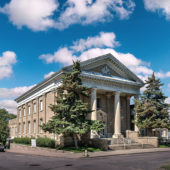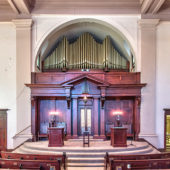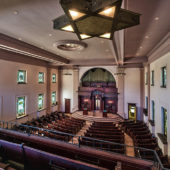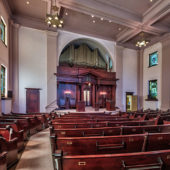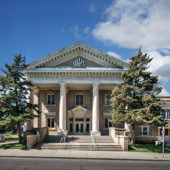One of the original founding members o the Union of American Hebrew Congregations.
The Ghost of Adath Joseph
“That place is haunted,” said the buck-toothed boy as he leaned over the handlebars of his bike. “What are you doing?” asked the freckle-faced girl who pulled up behind him. “Just photographing the building. It’s historic, more than 100 years old,” I said. The building was Temple Adath Joseph in St. Joseph, Missouri. It was a roasting hot Labor Day afternoon and we were photographing the exterior.
“How do you know it’s haunted” asked my wife. “The lady who cleans the place lives in the basement at the back and she says so,” said the boy. “She hears voices,” the girl chimed in. That was proof enough for me as I fantasized taking a snapshot of a ghost.
Ghosts and haunting aside, St. Joseph and its Jewish community have a colorful past. The first Jews came to the area illegally in the 1700s when it was still Louisiana Territory belonging to France. The French Code Noir laws, decreed by King Louis XIV in 1685, restricted the activities of free Negroes, forbade the exercise of any religion other than Roman Catholicism and ordered all Jews out of France’s colonies. Known as le Roi-Soleil (the Sun King), Louis XIV’s image as being enlightened was based upon his prissy couture and cavorting with sheep rather than his social views or tolerance of other cultures. When the United States purchased the Louisiana Territory in 1803, the area’s Jews became legitimized and more began to settle in the huge land that stretched from New Orleans to the Canadian border.
In 1843, the same year that St. Joseph was platted as a city, the first Jewish burial took place in Adath Joseph Cemetery. Only 5 years later, gold was discovered in California. Because of its ferry across the Missouri River, St. Joseph became the jumping-off point for those headed to the gold fields or the Oregon Territory. The town was a bustling place where pioneers would buy supplies, outfitting their covered wagons before heading west. Felix Street, the center of downtown, was dominated by Jewish businesses including opticians, kosher bakeries and butchers as well as merchants. To serve this burgeoning Jewish population, Congregation Adath Joseph was organized in 1856.
The fledgling congregation met in private homes until 1865 when a church building at Sixth and Edmond streets was purchased and remodeled. The prosperity of Jewish businesses and intrusion upon the city’s skyline by the church–remodeled synagogue were simply more than less progressive thinkers could stand. Within two weeks of Temple Adath Joseph’s dedication, arsonists successfully burnt it to the ground. Ironically, the only item saved was a single Torah: the Jewish scripture survived while the building that was once a church met its demise. Within only three years, a new 250 pew synagogue was built by St. Joseph’s 40 optimistic Jewish families. Like almost all congregations back then, Adath Joseph was Orthodox, yet shortly after the opening of its newly constructed synagogue, the unthinkable happened: women were allowed to participate in the choir. Soon the congregation began celebrating Rosh Hashanah on only one day instead of two. This downward spiral from orthodoxy culminated in 1873 when Adath Joseph joined 33 other congregations in the formation of the Union of American Hebrew Congregations (Reformed). It was the only congregation west of the Mississippi to have that distinction.
The Jews of St. Joseph had reason to be optimistic. More than being an important jumping-off point and trade center, the town was the base of an equine-propelled communications revolution. Owing to its propitious position and ferry across the Mighty Mo, it was home to the Pony Express. Using a series of relay stations, Pony Express riders reduced the time for messages and mail travel from the Atlantic coast to the Pacific to about 10 days. It was the West’s fastest and most direct means of east-west communication until it was eclipsed by the telegraph in 1861. In addition to dashing pony riders, St. Joseph lays claim to other colorful but infamous characters.
Construction on the current temple began in 1908 and was completed in 1910. An annex for social functions was added thirteen years later and in the 1950s Meyer Hall, new classrooms an Assembly Hall and a youth lounge were added.

